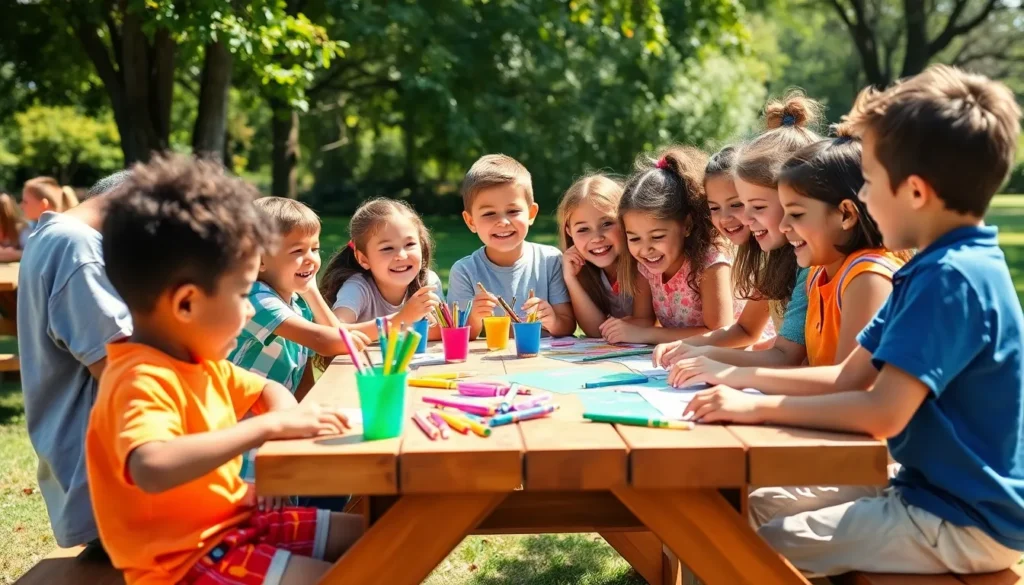Table of Contents
ToggleElementary kids are a whirlwind of energy, curiosity, and creativity. They’re the tiny tornadoes that turn classrooms into vibrant ecosystems where learning happens through laughter and play. From mastering the art of sharing crayons to navigating the complex world of playground politics, these young explorers are on a quest for knowledge and friendship.
But let’s be honest—keeping up with their boundless enthusiasm can be a challenge. One moment they’re asking profound questions about the universe, and the next, they’re convinced that broccoli is a monster. Understanding elementary kids isn’t just about teaching them; it’s about embracing their quirky ways and finding joy in their unique perspectives. Dive into the delightful chaos of childhood, and discover how to nurture their growth while keeping your sanity intact.
Understanding Elementary Kids
Elementary kids present a dynamic blend of curiosity and creativity. Their developmental and emotional needs shape their experiences and interactions.
Developmental Stages
Children in elementary school typically progress through distinct developmental stages. Cognitive abilities expand rapidly during these years, enhancing critical thinking skills. Social development also accelerates, as friends become central to their lives. Physical growth occurs, improving fine and gross motor skills. Language skills develop alongside these stages, enabling more complex conversations and expressions. Each child experiences growth uniquely, influenced by personal and environmental factors.
Emotional Needs
Emotional needs often play a significant role in a child’s overall development. Feeling secure and understood fosters healthy emotional growth. Children seek validation from peers and adults, impacting self-esteem. Expressing emotions is crucial; they thrive when encouraged to share thoughts openly. Developing coping mechanisms also proves essential for managing challenges. Supportive relationships with caregivers and teachers help meet these emotional needs effectively.
Engaging Activities for Elementary Kids

Elementary kids thrive on engaging activities that spark their creativity and energy. These activities play a crucial role in their development.
Creative Arts and Crafts
Creative arts and crafts capture the imagination of elementary kids. They enjoy painting, drawing, and working with clay. These activities enhance fine motor skills while allowing children to express emotions. Providing varied materials, like recycled items or natural objects, promotes exploration. For instance, making collages using leaves or magazines stimulates creativity. Teachers and parents can organize themed projects to encourage collaboration. Group activities, such as mural painting, foster teamwork. Engaging in arts and crafts not only boosts creativity but also builds confidence in artistic abilities.
Outdoor Games and Sports
Outdoor games and sports encourage physical activity among elementary kids. These activities help develop coordination and social skills. Popular options include soccer, tag, and obstacle courses. Participating in team sports instills a sense of belonging. When kids play together, they learn valuable lessons about teamwork and sportsmanship. Creating a fun and safe environment is essential for fostering participation. Parents can organize neighborhood games to build community spirit. Outdoor play is vital for overall health, promoting not just physical fitness but also emotional well-being.
Effective Learning Strategies for Elementary Kids
Elementary kids thrive in dynamic learning environments. They engage best when lessons incorporate interactive elements and hands-on activities.
Interactive Teaching Methods
Active participation enhances comprehension. Collaborative group work fosters communication skills and builds friendships. Incorporating games and role-playing makes learning enjoyable and memorable. This approach addresses diverse learning styles, catering to auditory, visual, and kinesthetic learners. Teachers can use storytelling to create relatable contexts that capture students’ attention. Additionally, art-based projects enable creative expression while reinforcing academic concepts. Overall, engaging methods form a strong foundation for effective learning experiences.
Incorporating Technology in Education
Technology serves as a valuable tool for enhancing education. Interactive apps and educational software can make learning more engaging. Virtual platforms encourage children to explore subjects in depth, fostering independence. Incorporating multimedia resources like videos and animations helps clarify complex topics. Furthermore, online collaboration tools can facilitate group projects, allowing children to communicate and work together, even remotely. These technological integrations prepare kids for a tech-savvy world while promoting essential skills like problem-solving and critical thinking.
Supporting Social Skills in Elementary Kids
Elementary kids benefit greatly from developing social skills, which lay the groundwork for collaboration and effective communication.
Importance of Teamwork
Working together fosters a sense of community among children. Teamwork teaches kids to share responsibilities and collaborate towards common goals. Group projects help children appreciate diverse perspectives, enhancing their understanding of different roles within a team. Engaging in sports or group activities builds camaraderie and encourages mutual respect. Active participation in these scenarios enables kids to develop negotiation skills, making it easier for them to express their ideas. Learning to cooperate and support peers strengthens friendships, which play a pivotal role in their social-emotional development.
Conflict Resolution Techniques
Children encounter conflicts during play, which presents opportunities for learning. Teaching them to recognize their feelings is crucial in understanding the emotions behind disagreements. Encouraging kids to articulate their viewpoints fosters open communication. Role-playing different scenarios provides practical experience in managing conflicts constructively. Promoting strategies like taking deep breaths or counting to ten before responding can help calm heated situations. Guiding kids towards finding solutions together empowers them to resolve issues amicably. Ultimately, these techniques cultivate resilience and adaptability necessary for navigating social challenges.
Embracing the vibrant world of elementary kids requires a blend of understanding and creativity. Their unique perspectives and boundless energy offer countless opportunities for growth and learning. By fostering supportive environments and engaging activities, caregivers and educators can significantly impact their emotional and social development.
Encouraging collaboration and creative expression not only enhances their skills but also nurtures resilience. As they navigate friendships and challenges, the right guidance can help them thrive. Investing in their holistic development today lays the foundation for confident and capable individuals tomorrow.


